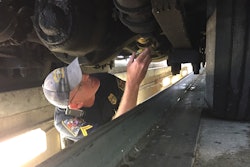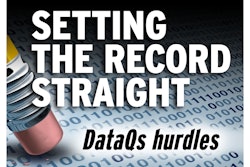Previously in this package: Criticism mounts of DataQs crash/inspection-info review system
Among the crash-related DataQs reviews in 2019, almost half were attempts to correct data about the carrier involved, or in some cases that was mistakenly said to be involved. Some problems stem from simple errors in recording or transferring the data. Others can be more complex. Any error can cause serious, sometimes lasting problems with safety ratings and then related issues, such as insurance coverage and premiums.
One way erroneous carrier information enters into accident and violation reports is when an owner-operator departs a fleet on bad terms while on the road. If the owner never bothers to get the fleet’s DOT number removed from his truck and has a wreck, it can mean going down an expensive, lengthy paper trail to get it fixed, said Christopher Haney, director of safety and human resources for Payne Trucking, a 130-truck fleet based in Fredericksburg, Virginia.
“All of a sudden I get an accident report through CSA,” he said. “So now I have to go in, produce a phenomenal amount of documentation to show this driver is no longer affiliated with our company.”
In a 2019 case, Haney did just that and won the appeal. “But I have colleagues who’ve had similar problems and were told there was nothing they could do about it,” he said. When such a case advances to a lawsuit, “I now have to defend it. I’ve got to hire counsel. That can cost tens of thousands of dollars, up to six figures, to prove I’ve done nothing wrong.”

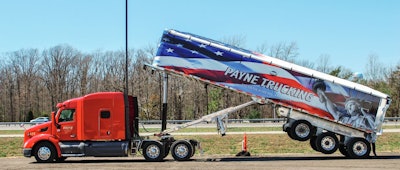 Payne Trucking, based in Fredericksburg, Virginia, has been careful to use DataQs only when there is compelling evidence to submit, said Christopher Haney, director of safety and human resources. He said he’s had a perfect record in successful DataQs submissions.
Payne Trucking, based in Fredericksburg, Virginia, has been careful to use DataQs only when there is compelling evidence to submit, said Christopher Haney, director of safety and human resources. He said he’s had a perfect record in successful DataQs submissions.
Incorrect-information cases like this are well more important than some enforcement officers realize, said Adam Kleinschmidt, working in the compliance department of the Owner-Operator Independent Drivers Association. “If you get an inspection of a truck or driver not belonging to you, your insurance is going to cancel your policy.”
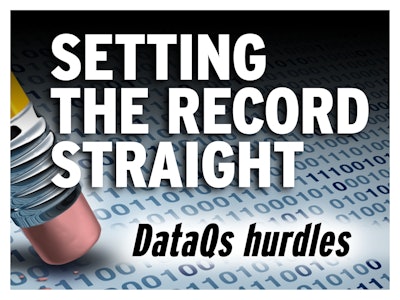
Situations like those described by Payne and Kleinschmidt show that “one little tiny frigging violation has a lot more weight” than what many FMCSA officials acknowledge, as Payne said. “They don’t understand what happens down the line because of these gaps, because of these failures.”
Wrong-carrier DataQs, according to federal data for 2019, make up almost half of all crash DataQs, and about a fourth of those related to inspections/violations. They result in a change a large majority of the time – at 89% (crash-related) and 82% (inspection-related) rates.
Yet the volume of such requests underscores their importance for carriers. And though many may well be simple clerical errors in recording the right DOT number by the officer, they can be “sticky,” or hard to resolve, and not just on the crash side of the DataQs ledger, said Captain Jon Olsen of the Minnesota State Patrol.
He lumps them in with no-citation violation challenges as perhaps the most labor-intensive of all those that his department’s DataQs administrator is tasked with evaluating. “In a perfect world, we like to get that started and done in 60 days,” he says of the evaluation timing on these most challenging of DataQs types.
“We’ve had issues where someone will claim that a driver’s ‘tried to work for us but we’ve never worked with them,’” Olsen said, DOT numbers of the side of the truck notwithstanding. Or: Claims about the timing of a firing that arise – was the operator let go before or after that crash or inspection with 10 violations?
 Resolving factual errors about a fleet might seem straightforward enough, but that can be as labor-intensive as addressing challenges to violations where no citation was issued, said Captain Jon Olsen of the Minnesota State Patrol.
Resolving factual errors about a fleet might seem straightforward enough, but that can be as labor-intensive as addressing challenges to violations where no citation was issued, said Captain Jon Olsen of the Minnesota State Patrol.
“Those are the hardest to resolve,” Wright added.
As shown in the graph below, there’s little significant per-carrier variation when it comes to the success rate of crash RDRs by fleet size, with the exception of the two extremes in size categories. One-vehicle operators succeeded in 75% of their appeals, while fleets of over 500 trucks saw a 76% success rate. The six size categories in between varied between 46% and 56%, with no particular correlation of size and success.
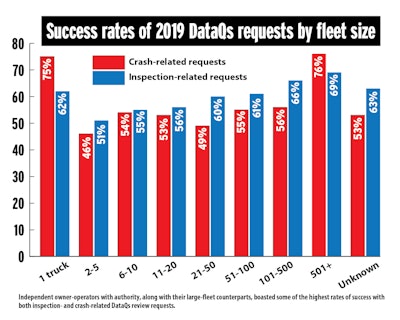
With inspection-related DataQs, however, success tends to improve with fleet size. The lowest success rate was 51% for two to five vehicles, the highest 69% for more than 500 vehicles.
A big part of the advantage that the largest carriers have over smaller ones in inspections is many large carriers never operate “a truck that’s not in warranty,” National Association of Small Trucking Companies President David Owen said, so it’s less likely the trucks will be cited for inspection violations in the first place. Those large carriers also have terminals all over the country to keep up with maintenance.
Captain Olsen, too, sees what he feels is an understandable reason for a large carrier’s success in navigating DataQs to effect. “They have the most horsepower to be able to research and file the challenges and follow the steps through to the end,” he said. “It’s not the easiest process. There’s labor involved, for us and for the carrier.”
Overdrive’s accounting of inspection incidence throughout the years in the CSA’s Data Trail series has consistently shown the one-truck carrier – independents with operating authority -- as the most-often inspected of all carrier sizes on a per-power-unit basis. Yet those smallest of small carriers beat out all but the largest size groups in success rates for crash- and inspection-related DataQs.
Olsen at first struggled to understand why success rates would be so high for one-truck independents, noting that some small carriers seem to fall short on communication with drivers about regulations. That’s particularly been the case in the last year when it comes to drivers claiming pandemic-related emergency exemptions to the hours of service.
Too often, he said, drivers have assumed a food load qualified when the shipper, receiver and/or carrier made no such assumption. That presumptuous driver “just earned himself a 10-hour nap” in many cases, Olsen said. “If you’re a safety director or owner of a small fleet, the education and information that you feed your driver is so key and so critical to the whole process” of compliance.
“That’s why, maybe,” he added, “the owner-operator is so successful” with DataQs. “They know everything about what they’ve done and where they’ve been. There’s fewer issues with them overall.”
Read next: Two states, CVSA lead way in countering DataQs appeals bias
More in the "Setting the Record Straight" package:
Criticism mounts of DataQs crash/inspection-info review system
How to mount an effective DataQs challenge
Podcast: Fairness in Minnesota's DataQs appeals process
